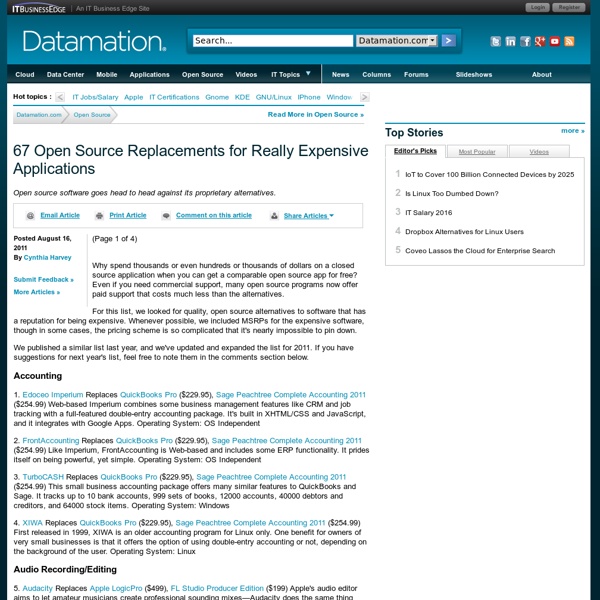15+ Awesome Open Source Graphics Software List
Cenon – Cenon is a graphical tool of a special kind. Build upon a modular graphical core, Cenon offers a wide variety of possibilities and applications. The best of all, the Cenon core is free software, available with full source codes, and at home on many computer platforms. It is capable of doing Desktop publishing, vector graphic transformation etc. Dia – Dia is roughly inspired by the commercial Windows program ‘Visio’, though more geared towards informal diagrams for casual use. It can be used to draw many different kinds of diagrams.
SCIgen - An Automatic CS Paper Generator
SCIgen - An Automatic CS Paper Generator About SCIgen is a program that generates random Computer Science research papers, including graphs, figures, and citations. It uses a hand-written context-free grammar to form all elements of the papers.
Please don't send me Microsoft Word documents - nothingisreal.com
Most likely you have been directed to this document because you have attempted to e-mail me a document in Microsoft Word format. I would like to explain to you why I am probably not able to access this document, why you should reconsider sending Word documents to people, and what better alternatives are available for document exchange over the Internet. Why it's a bad idea to send Microsoft Word documents Microsoft Word documents cannot always be read by other word processors. The specification for Microsoft Word documents is a closely-guarded secret, and as such only software from Microsoft is capable of reading Word files correctly. People who use other word processors, either by choice or by necessity, may be unable to open Word documents.
Find cleartext passwords in memory dump
The Random Access Memory (RAM) is where system components, applications and other data is kept, while the computer is working with it. It is placed there often in clear text for fast access, but there is a security risk involved in this, which is often ignored. In this tutorial, we’ll try dumping the content of the memory to the hard drive and find username and password information stored in the file. Start by logging in to your email, Microsoft account or whatever, to make sure that the information is placed in the memory. You can log out, close your browser afterwards – doesn’t matter. Now we need to dump the memory to the hard drive.
simple - Simple Compiler And Runtime
Update: We fixed a couple more problems with the Windows binary distribution. The download file has been updated. Our apologies! Version 0.1.1 also contains a new component for a location sensor.
Faceshift: real-time in-game facial expressions using Kinect – Video Games Reviews, Cheats
The EPFL Computer Graphics and Geometry Laboratory in Switzerland carries out research in a number of areas including computational symmetry, architectural geometry, shape analysis, geometric art, physics-based animations, and performance capture. It’s that last one we’re interested in today though, as it promises to have a huge impact on video games. The video above shows EPFL’s latest research into performance capture using the Kinect motion controller. It’s called Faceshift, and provides a simple way to translate your own facial expressions on to a game character in real-time. There’s nothing you have to wear for this to happen, just let a Kinect sensor point at your face and the Faceshift system does the hard work.
Building a SaaS Startup in One of the Least Hospitable Places on Earth: Japan
For those considering a start-up, the story of Jason Winder’s new venture, MakeLeaps, provides an uplifting educational and inspiring read. Winder came to Japan in 2001 speaking little Japanese and without a college education. Yet with drive, focus and passion, he is now working on his second venture. Winder is an Ichiban Entrepreneur. Winder began working for an IT consultancy shortly after arriving in Japan.
Which MacBook Air To Buy? Get The 128GB 11-Inch Model With 4GB of RAM. Here’s Why
Today, Apple released new Sandy Bridge MacBook Airs with Thunderbolt ports, backlit keyboards and all-around upped specs. Any MacBook Air you get will, in all likelihood, be the best laptop you’ve ever owned, but how do you know which MacBook Air is right for you? After nine months of using and loving our last-gen MacBook Airs, we know which one we’d recommend to most people: the 128GB 11-inch MacBook Air with 4GB of RAM . Here’s why.
Who needs to pirate software with a list like this? [Archive] - Jatland Forums
3D Graphics: 3Delight Free - Anim8or - Aqsis - Blender - Houdini (Free Edition) - Now3D - OpenFX - POV-Ray - SOFTIMAGE|XSI EXP - Terragen - Toxic - Wings 3D - Anti-Virus: a-squared - AntiVir - Avast - AVG - BitDefender - ClamWin - Anti Spyware: Ad-aware - Bazooka - Hijackthis - SpyBot Search & Destroy - SpywareBlaster - SpywareGuard - WinPatrol - Audio Creation Gungirl Sequencer - HammerHead - Jesusonic - KRISTAL Audio Engine - orDrumbox - Tu2 - Audio Players: 1by1 - Billy - CoolPlayer - DeejaySystem MK1 - DeliPlayer.
Software architect Kristof Kovacs
Just a list of 20 (now 28) tools for the command line. Some are little-known, some are just too useful to miss, some are pure obscure -- I hope you find something useful that you weren't aware of yet! Use your operating system's package manager to install most of them.
The Top 50 Proprietary Programs that Drive You Crazy — and Their Open Source Alternatives
The Top 50 Proprietary Programs that Drive You Crazy — and Their Open Source Alternatives Update January 22, 2013: This article was originally posted February 7, 2008. Since then, it has been one of our most popular articles here at WHdb.com. In light of this, we have decided to give this article an update for 2013: we cleaned out some obsolete links and added a New for 2013 section. Enjoy!



